Seed drill
Vineyard seed drills can be used to establish plant cover. They may require prior tillage of the soil, as is the case with packer roller seeders, or allow direct sowing without preparation. Their even distribution and versatility for different seed sizes are essential. Models include seed drills combined with tillage, seed drills for direct seeding and seed drills for broadcast seeding.
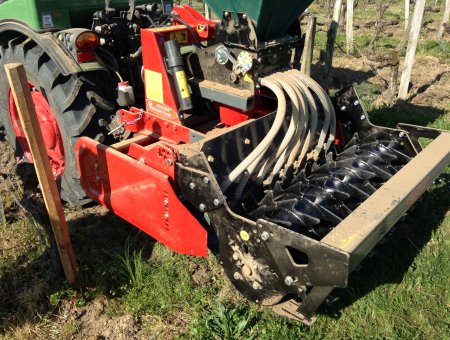
Work objective
The purpose of using seed drills is to establish plant cover. Various seed placement techniques are used, some of which require the prior use of soil preparation equipment (e.g. packer roller seeders), while others allow seeding without the prior use of tools.
Whatever the equipment chosen, the seed drill's distribution system must meet precise specifications: distribution must be even, metering must be possible even for small seeds with low metering rates, and it must be versatile in terms of the size of seeds allowed.
To accommodate this versatility, seed drills are sometimes fitted with interchangeable metering devices adapted to seed size. For others, a single device can cover all requirements, subject to a few prior adjustments.
Whatever the equipment chosen, the seed drill's distribution system must meet precise specifications: distribution must be even, metering must be possible even for small seeds with low metering rates, and it must be versatile in terms of the size of seeds allowed.
To accommodate this versatility, seed drills are sometimes fitted with interchangeable metering devices adapted to seed size. For others, a single device can cover all requirements, subject to a few prior adjustments.
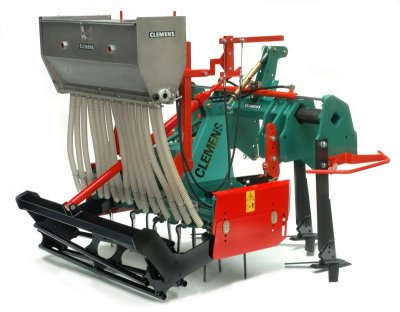
Seed drill - Clemens
Different types of seed drill
Seed drills combined with tillage
This type of equipment prepares the soil and seeds in a single pass. The soil is generally worked by a rotary harrow, but some machines use a horizontal axis rotary hoe ("Rotavator") whose reverse rotation combined with a comb ensures that stones are buried (Dairon).Seed drills for direct seeding and overseeding
These machines allow seeds to be placed without prior tilling of the soil, without disturbing the soil structure too much.Vredo in particular uses double discs to form the furrow, and the associated fluted seeder can be used to apply rates of 3 to 300 kg/ha.
For its GNK range, Amazone offers a seed drill combined with a reciprocating harrow, whose flexible rear-facing tines limit the destruction of plant cover and allow for replanting. On this machine, distribution is in the form of broadcast sowing, whereas on the previous machine it is row sowing.
These machines are expensive, costing well over €10,000.
Packer roller seed drills
This is typically the equipment for CUMAs or hire companies, as it is simple and robust. The seeds are distributed between the two rows of the roller, which allows the seeds to be buried. The disadvantage of this seeder is that it requires the soil to be prepared beforehand , using a powered tool to create a sufficiently crumbled seedbed.Seed drills for broadcast seeding
This is often done by hand using fertiliser spreaders, which are limited by the low dosage required. However, this limitation can be overcome by mixing sand and seed.Delimbe distributors, originally designed for micro-granules, allow this type of seeding (or can be combined with packer rollers).
This type of equipment can also be used tolocate seeds under the row in the case of full grass cover, thanks to the use of a fan to transport the seeds.
Lehner offers a centrifugal seeder whose operating mode is a replica of the centrifugal fertiliser spreader.
Components of seed drills
Seed drills, whether for broadcast or direct seeding, are made up of different components:The hopper
The hopper transports and feeds the seed to the sowing units. It is generally made of steel. Manufacturers offer a range of hopper capacities. When planting cover crops made up of different seed varieties, it is advisable to use low-capacity hoppers with silent blocks connecting the hopper to the frame. This will limit sedimentation of the smallest seeds in the bottom of the hopper.
Aurensan offers a double or even triple compartment hopper. This allows seeds of different sizes to be separated.
Aurensan offers a double or even triple compartment hopper. This allows seeds of different sizes to be separated.
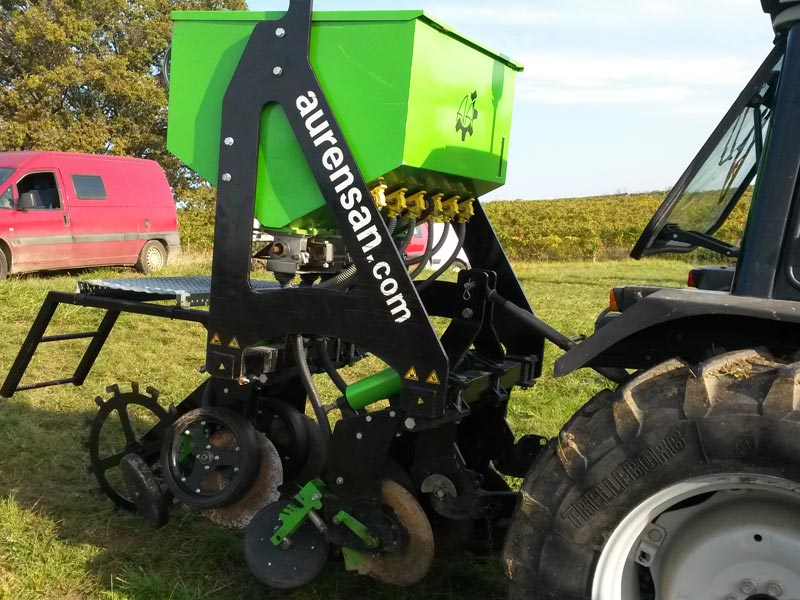
Seed drill - Aurensan
The distributor
The distributor transports the seed to the seeding unit. The distributor used to be driven mechanically, but manufacturers now offer an electric drive. To optimise seed distribution to the sowing units, some manufacturers couple the distributor with a blower system. This accessory is essential for equipment with a seeding width of more than 2 m.The manufacturer Aitchinson offers an atypical distributor consisting of a foam disc. This technology considerably reduces the constraints involved in establishing certain plant cover made up of seeds of different sizes, or in planting small seeds at low rates per hectare.
The distributor can be driven mechanically or electrically. The simplest is the Advance Proportional Flow (APF). With electrically driven distributors, the flow rate is constant, so it's important to control your forward speed.
Sowing units
Sowing units are used to place the seed on the ground. Depending on the seeding technique used, these are simple dispersers for broadcast seeding.
Several configurations are available for direct seeding.
There are seed drills on the market fitted with tines, discs or combined tines and discs. When choosing a seeder, it's important to take into account a number of parameters, including the type of soil and the type of cover to be planted.
Several configurations are available for direct seeding.
There are seed drills on the market fitted with tines, discs or combined tines and discs. When choosing a seeder, it's important to take into account a number of parameters, including the type of soil and the type of cover to be planted.

Seed drill - Braun
Seed drill settings and use
Broadcast seeding
Generally fairly simple in design, the adjustment of a seed drill differs according to the seed distributor drive system, which may be constant flow or proportional to forward travel.For convenience, seed drills are calibrated statically on a flat area. When sowing in the field, a slight variation in dosage/ha may be observed. This is generally due to vibrations (when working) which increase the flow rate/ha.
| Technique | Advantages | Limitations |
|---|---|---|
| Broadcast sowing |
|
|

Broadcast seeding adjustment
Seeding operation
Using a broadcast seeder requires a seedbed to be created. Several passes may be necessary to obtain a correct seedbed (well-crumbled structure, low proportion of weeds, sufficient levelling of the soil, etc.).The sowing stage is simplified as all you have to do is spread the seed on the ground, respecting the set sowing width, and then roll the seed. It is preferable to carry out these two operations simultaneously.
Packing the seed is essential. This is generally done by a "cultipacker" type roller. The most advanced direct seeding equipment is fitted with wheels positioned at an angle on either side of the furrow or directly on the sowing line.
Setting up a broadcast seed drill
Seed drill with a mechanically driven distributor (flow rate proportional to forward speed)
- Step 1: Determine the dose/ha (Q) for sowing 100 m² (for example)
Q (kg) = dose/ha
100
- Step 2: Determine the distance to be covered (D) to sow 100 m²
D (m) = 100
working width of seed drill (m)
- Step 3: Determine the circumference (C) of the seeding unit drive wheel
However, if the drive wheel is fitted with a tyre, the latter may deform under the weight of the seeder. To determine its circumference, make a mark on the sidewall of the tyre, place the seed drill on the ground (preferably with the mark at the bottom), drive forward a certain number of wheel revolutions (5 to 10) and measure the distance covered. This distance will be divided by the number of wheel revolutions to obtain the precise circumference of the drive wheel.
- Step 4: Determine the number of primary drive revolutions (N) required to distribute the seed over the distance defined in step 2
N = D
C
D (m) = distance to be covered to sow 100m3
C (m) = circumference of drive wheel
C
D (m) = distance to be covered to sow 100m3
C (m) = circumference of drive wheel
- Step 5: Check the setting
- place a small volume of seed in the hopper,
- turn the drive wheel on the distributor to saturate it,
- place bags at each distribution chute or a tarpaulin under the seed drill, so that the seed can be easily recovered,
- turn the drive wheel by the number of revolutions (N) determined in step 4,
- collect the seed,
- weigh it,
- readjust the distributor opening if necessary.
EXAMPLE:
Plot density: 5,000 plants/ha
Sowing a mixture (oats vetch): 100 kg / ha
Seeding width in the row: 1.4 m
Cultipacker" roller (driving the distributor): diameter 600 mm
Stage 1:
q = 100 (kg/ha) / 100 (m²)
q = 1 kg to sow 100 m²
Step 2:
d = 100 (m²) / 1.4 (working width of seed drill in m)
d = 71.4 m
Plot density: 5,000 plants/ha
Sowing a mixture (oats vetch): 100 kg / ha
Seeding width in the row: 1.4 m
Cultipacker" roller (driving the distributor): diameter 600 mm
Stage 1:
q = 100 (kg/ha) / 100 (m²)
q = 1 kg to sow 100 m²
Step 2:
d = 100 (m²) / 1.4 (working width of seed drill in m)
d = 71.4 m
Step 3:
c = ¶ x 60 (diameter of cultipacker roller in cm)
c = 188 cm
c ˜ 1.9 m
Step 4:
n = D / C
n = 71,4 / 1,9
n = 37.5 revolutions
Step 5:
Make 37.5 turns of the drive wheel, weigh the quantity of seed recovered, if the quantity is not equal to 1 kg, adjust the opening of the distributor then repeat step 5 until the desired dosage is obtained.
c = ¶ x 60 (diameter of cultipacker roller in cm)
c = 188 cm
c ˜ 1.9 m
Step 4:
n = D / C
n = 71,4 / 1,9
n = 37.5 revolutions
Step 5:
Make 37.5 turns of the drive wheel, weigh the quantity of seed recovered, if the quantity is not equal to 1 kg, adjust the opening of the distributor then repeat step 5 until the desired dosage is obtained.
Seed drill with an electrically driven distributor (constant flow rate)
These are generally microgranulators (Delimbe, Sepeba, etc.). The simplest method is to determine a flow rate in Kg/min, using the calculation formula D=(QxLxV)/600
- Step 1: Determine the working width (L) in m.
This corresponds to the seeding width of the seed drill. - Step 2: Determine the forward speed (V) in km/h.
The forward speed will depend on the composition of the seed drill. In the case of combined equipment (seed drill + seedbed preparation tool), the speed should be relatively moderate to enable the rotary tool preceding the seed drill to work under good conditions. - Step 3: Determine the seeding rate (Q) in kg/ha.
This corresponds to the full hectare dose. - Step 4: Calculate the theoretical seed drill output (Dt) in kg/min.
Dt = (QxLxV)/600
W = working width (m)
V = forward speed (km/h)
D = seeding rate (kg/ha) - Step 5: Adjust the distributor using the manufacturer's chart.
Simply refer to the chart provided by the manufacturer and use the setting value corresponding to the theoretical flow rate determined in step 4. - Step 6: Check the setting
- place a small volume of seed in the hopper,
- activate the electric distributor to saturate it,
- place bags at each distribution chute or a tarpaulin under the seed drill, so that the seed can be easily recovered,
- activate the electric distributor for a specific time (1 minute for example),
- collect the seed
- weigh it,
- readjust the speed of rotation of the distributor if necessary.
EXAMPLE:
Plot density: 5000 plants/ha
Sowing a mixture (oats vetch): 100 kg / ha
Seeding width in the row: 1.4 m
forward speed: 6 km / h
Stage 1:
l = 1.4 (m)
Stage 2:
v = 6 (km/h)
Plot density: 5000 plants/ha
Sowing a mixture (oats vetch): 100 kg / ha
Seeding width in the row: 1.4 m
forward speed: 6 km / h
Stage 1:
l = 1.4 (m)
Stage 2:
v = 6 (km/h)
Stage 3:
d = 100 (kg/ha)
Step 4:
dt = (100 x 1.4 x 6) / 600
dt = 1.4 (kg/min)
Step 6:
To check the accuracy of the setting, simply collect the seed and distribute it for 1 minute, weigh it and adjust the setting if necessary.
d = 100 (kg/ha)
Step 4:
dt = (100 x 1.4 x 6) / 600
dt = 1.4 (kg/min)
Step 6:
To check the accuracy of the setting, simply collect the seed and distribute it for 1 minute, weigh it and adjust the setting if necessary.
Direct seeding
This technique, widely used in arable farming, seems to be developing in viticulture.
The various types of equipment on the market generally consist of a hopper, devices for cutting the weed in place and positioning the seed, then a roller to bring the soil and seed into contact.
The various types of equipment on the market generally consist of a hopper, devices for cutting the weed in place and positioning the seed, then a roller to bring the soil and seed into contact.
| Technique | Advantages | Limitations |
|---|---|---|
| Direct seeding |
|
|
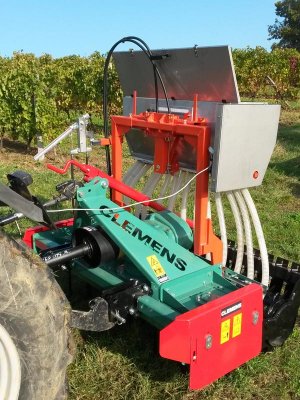
Direct seeder
Seed placement
Although much less restrictive than broadcast sowing, semi-direct planting requires certain parameters to be met:
- the soil must be cool enough (neither too wet nor too dry) to ensure even emergence of the seed,
- the surface must be relatively flat to allow precise adjustment of the seeding depth,
- the choice of species will depend on the seeder's ability to place seeds of varying sizes. Few direct seeding machines are capable of planting faba beans, for example. Some manufacturers therefore offer a hopper with multiple compartments, each fitted with a distributor. This makes seeding more precise.
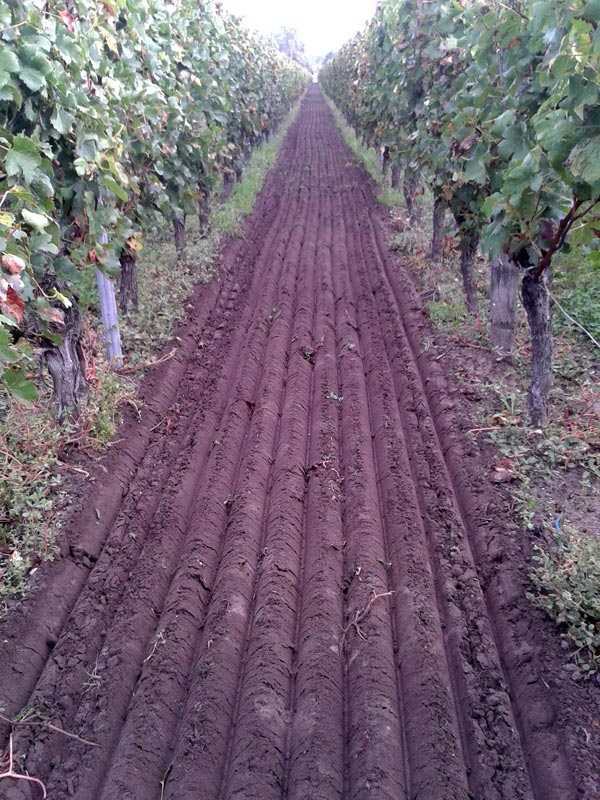
Fresh soil ready for sowing
Setting up a no-till drill
No-till seed drills use a distribution system comparable to that of broadcast seed drills. The distributor settings are therefore identical.However, there is one important parameter that needs to be taken into account when establishing plant cover using direct seeding: the depth at which the seed is planted. This can be adjusted using various technical solutions, such as depth wheels on the frame or on each sowing unit.













